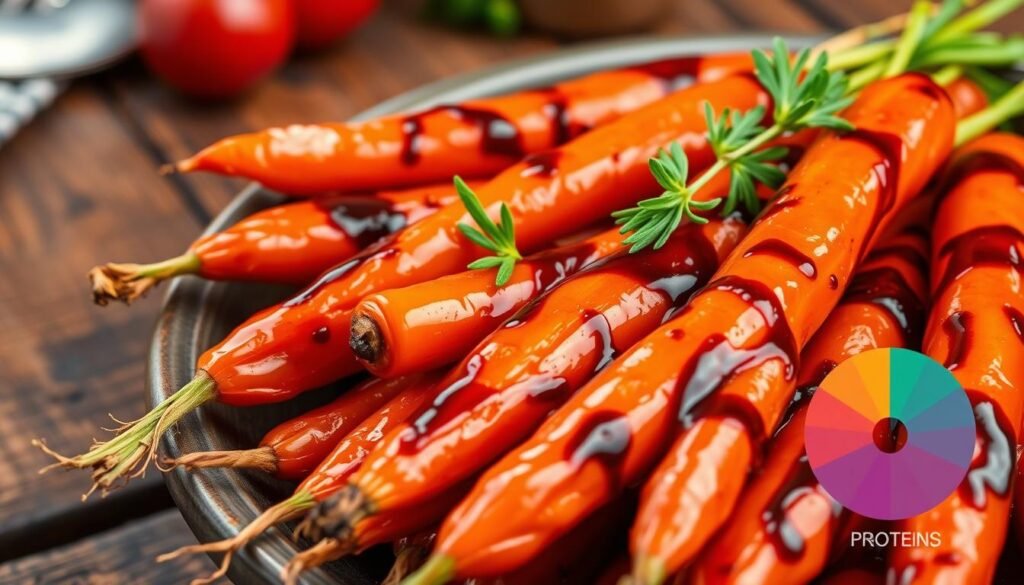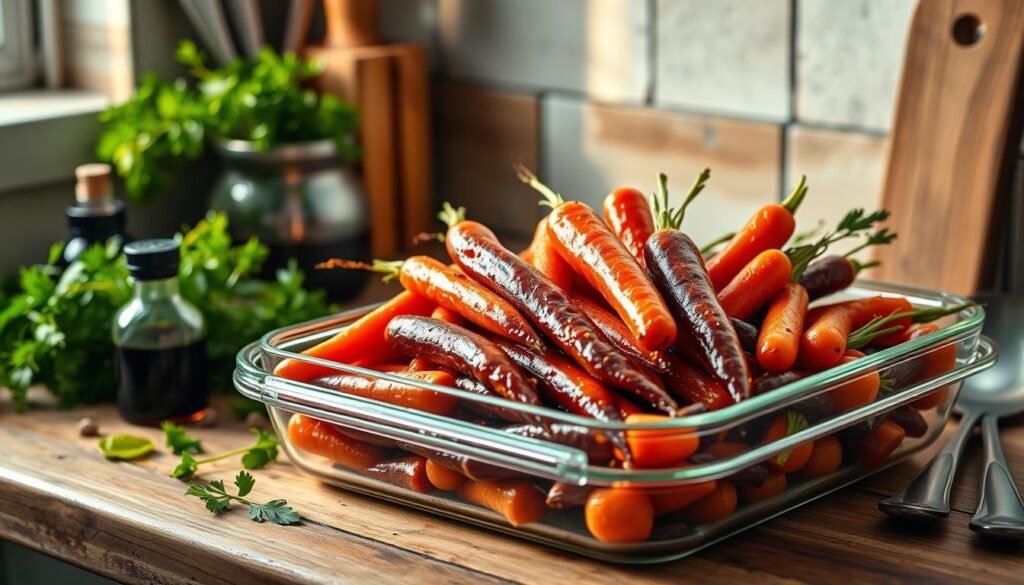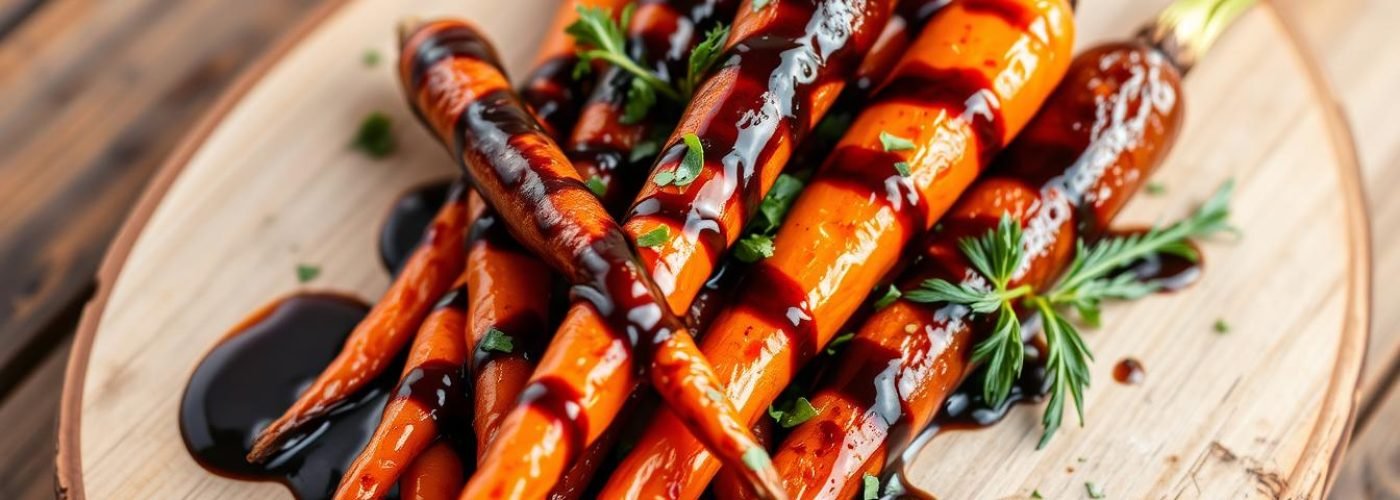Discover a vibrant and flavor-packed way to enjoy your veggies with our Low-Fat Balsamic Glazed Carrots. This delightful recipe is more than just a side dish; it brings together the natural sweetness of carrots with the tangy richness of balsamic glaze, all while keeping the fat content low. Perfect for anyone exploring healthy carrot recipes, this dish stands out as a nutritious side option that complements any meal.
Whether you are looking to enhance your dinners or simply want to add a burst of color and taste to your plate, these Low-Fat Balsamic Glazed Carrots fit the bill. Stay tuned as we delve into the preparation details, health benefits, and cooking techniques that will have you serving this deliciously healthy side in no time!
Introduction to Balsamic Glazed Carrots
Balsamic glazed carrots bring together the natural sweetness of fresh carrots and the tangy richness of balsamic vinegar. This delightful side dish not only enhances the flavor profile of your plate but also introduces a vibrant pop of color, making it visually appealing. The approach to healthy cooking using balsamic vinegar offers a flavorful alternative to traditional cooking fats and sugars, capturing a delicious essence that satisfies both the palate and nutritional goals.
Rich in antioxidants, balsamic vinegar complements the nutritional benefits of carrots, allowing you to enjoy a dish that is both tasty and health-conscious. Balsamic glazed carrots easily fit within a variety of vegetable recipes, making them a versatile addition to any meal. Whether served alongside lean proteins or as part of a festive spread, this dish stands out as a favorite for those seeking wholesome cooking options.
The Benefits of Low-Fat Cooking
Low-fat cooking offers numerous low-fat cooking benefits that can enhance your overall well-being. By focusing on reducing caloric intake, this method promotes effective weight management, making it an ideal choice for many. Incorporating fresh ingredients and lean proteins leads to nutritious meal preparation that balances flavor with health.
One significant advantage of low-fat diets is their contribution to lower cholesterol levels, which in turn supports improved heart health. In a world filled with processed foods, embracing a low-fat cooking style encourages the use of wholesome ingredients. These choices not only help you make better eating decisions but also inspire creative food pairings that can elevate everyday meals.
Delicious flavors emerge from low-fat cooking without the necessity of heavy fats, ensuring meals remain fulfilling and satisfying. Adopting this approach allows for a variety of tastes and textures, making it easier to maintain a healthy and enjoyable diet.
What You Need for Low-Fat Balsamic Glazed Carrots
Creating a delightful dish of Low-Fat Balsamic Glazed Carrots requires a simple list of ingredients. These ingredients come together to provide both flavor and nutrition, making this a perfect healthy carrot recipe. Below are the key components you’ll need to prepare this vibrant side dish.
Ingredients List
- 1 lb fresh carrots, peeled and sliced
- 3 tablespoons balsamic vinegar
- 1 tablespoon honey or maple syrup (optional for sweetness)
- 1 teaspoon olive oil (optional, for minimal fat)
- Salt and pepper to taste
- Fresh parsley for garnish (optional)
These essential ingredients for balsamic glazed carrots are easy to find at any grocery store. Utilizing healthy carrot recipe ingredients helps maintain the dish’s low-fat appeal while enhancing its natural sweetness.
Optional Ingredients for Variation
For those who wish to explore different flavor profiles, consider some carrot recipe variations. Here are a few alternative ingredients for glazed carrots to consider:
- Thyme or rosemary for a herbal aroma
- A pinch of red pepper flakes for a spicy kick
- Chopped nuts (e.g., walnuts or pecans) for added crunch and nutrition
These variations can elevate your dish without sacrificing its healthful qualities. Embrace your creativity in the kitchen and experiment with these enhancements for an even more enjoyable meal.
Step-by-Step Instructions for Preparation
Learning how to make balsamic glazed carrots is simple and rewarding. Follow these cooking steps for glazed carrots to create a delicious side dish that everyone will enjoy.
- Begin by peeling and slicing the carrots into evenly sized pieces. This ensures uniform cooking, allowing all pieces to be tender at the same time.
- In a large pot, bring water to a boil and add the sliced carrots. Boil for about 5-7 minutes, just until tender yet still slightly crisp. Drain the carrots well.
- Using the same pot, reduce the heat to medium. Add balsamic vinegar along with honey or maple syrup if desired. Stir the mixture to combine and allow it to simmer for about 1-2 minutes.
- Return the drained carrots to the pot, tossing them gently to ensure they are coated evenly in the balsamic mixture.
- Season the dish with salt, pepper, and a drizzle of olive oil if you wish. Allow the carrots to cook in the glaze for an additional 2-3 minutes to absorb the flavors.
- Remove the pot from heat, garnishing the carrots with fresh parsley before serving for a touch of color and flavor.
Enjoy your homemade balsamic glazed carrots as a flavorful and healthy side dish for any meal!
Cooking Techniques for Perfect Glazed Carrots
Choosing the right cooking method can dramatically impact the flavor and texture of your carrots. Whether you prefer boiling vs. steaming carrots, each approach has its benefits. Understanding these methods can help you select the best cooking methods for carrots that suit your taste and health needs.
Boiling vs. Steaming: Which is Better?
Boiling carrots is an effective technique for quickly softening them while allowing the carrots to absorb all the flavors from the glaze. This method often results in tender, flavorful carrots. Alternatively, steaming retains more nutrients and prevents the carrots from becoming waterlogged, which keeps their color vibrant and texture firmer. When deciding between the two, consider the texture and nutrient retention you desire in your dish.
How to Achieve the Perfect Glaze
To achieve perfect glaze, first bring the balsamic mixture to a gentle simmer before adding the cooked carrots. This simmering process ensures that the vinegar reduces, concentrating its flavor while enhancing the sweetness. Remember to continuously toss or stir the carrots in the glaze to promote even coating. Additionally, these tips for glazing vegetables will help you avoid burning and ensure that every bite is succulent.
Understanding Macronutrients in This Recipe
When it comes to enjoying Low-Fat Balsamic Glazed Carrots, understanding the macronutrient contribution of this dish allows for better dietary choices. This recipe not only pleases the palate but also aligns with health-conscious eating. Let’s break down the nutritional information balsamic glazed carrots to appreciate their benefits.
Caloric Breakdown
Each serving of Low-Fat Balsamic Glazed Carrots contains approximately 100 calories. This low-calorie profile makes it a perfect side dish for those managing their caloric intake. The caloric breakdown carrots feature shows that this dish fits seamlessly into various meal plans.
Protein, Carbs, and Fats Overview
The macronutrient composition is quite impressive in its balance. Each serving provides:
| Macronutrient | Amount per Serving |
|---|---|
| Protein | 2 grams |
| Carbohydrates | 23 grams |
| Fats | 0.5 grams |
The protein content carrots is relatively modest but complements the minimal fat content. The carbohydrate content balsamic glazed carrots mostly comes from the natural sugars in the carrots, enhancing their sweetness without adding a significant calorie burden. This balance makes them an excellent addition to a variety of healthy diets.

Serving Suggestions for Your Balsamic Glazed Carrots
Serving ideas for glazed carrots can elevate your dining experience. These Low-Fat Balsamic Glazed Carrots pair wonderfully with grilled chicken, fish, or tofu, making for a satisfying and nutritious meal. For festive occasions or family gatherings, include these carrots as a delightful side dish alongside traditional favorites.
To create a visually appealing plate, consider the following:
- Accompany with a fresh side salad for added texture and color.
- Include crusty whole-grain bread to round out the meal.
- Serve alongside roasted potatoes or quinoa for a heartier option.
These simple pairing suggestions for carrots ensure that your meal is both balanced and flavorful. Guests will appreciate the harmony of tastes and textures, making your dining experience truly memorable.
| Complementary Dish | Flavor Profile | Texture |
|---|---|---|
| Grilled Chicken | Savory, Slightly Smoky | Tender |
| Fish | Light, Flaky | Delicate |
| Tofu | Umami, Soft | Creamy |
| Side Salad | Crisp, Fresh | Crunchy |
| Crusty Whole-Grain Bread | Nutty, Earthy | Crusty |
Pairing Balsamic Glazed Carrots with Other Dishes
Balsamic glazed carrots can be the star of the meal, but choosing the right complementary side dishes and proteins elevates the dining experience. A well-rounded meal becomes a culinary triumph with thoughtful pairings that enhance the flavors of each ingredient.
Side Dishes that Complement Carrots
To achieve balance on your plate, consider these options:
- Quinoa or brown rice salads that add wholesome grains.
- Roasted Brussels sprouts or green beans for vibrant colors and texture.
- Mashed potatoes with garlic for a creamy and rich contrast.
These are among the best sides for glazed carrots, creating a colorful and nutritious side dish ensemble that pleases the palate.
Perfect Proteins to Serve Alongside
Protein pairings for carrots offers numerous health benefits and tasty choices. Consider these delicious options:
- Grilled salmon, providing a flavor-packed and healthy addition.
- Herb-marinated chicken breasts for added savoriness.
- Lentils or chickpeas for a vegetarian option that is high in protein and fiber.
These selections represent some of the best proteins with balsamic glazed carrots, enhancing the overall meal while ensuring a satisfying balance of flavors and nutrients.
Storing and Reheating Leftovers
After enjoying your flavorful Balsamic Glazed Carrots, it’s important to focus on storing glazed carrots properly. Place any leftovers in an airtight container and refrigerate them promptly. These delicious carrots can typically last up to four days in the fridge, ensuring you have a delightful side dish ready for another meal.
When it comes to reheating tips for leftovers, there are a couple of effective methods. A popular option is to warm them in a skillet over medium heat. Be sure to stir occasionally until they are heated through. Alternatively, you can use a microwave on a low setting, which might help in retaining their texture. It’s crucial to avoid overheating, as this may compromise the flavor and texture of the carrots.

Health Benefits of Carrots in Your Diet
Carrots are celebrated not only for their crunchy texture and sweet flavor but also for their impressive health benefits. One of the most significant nutritional benefits of eating carrots is their high beta-carotene content, which the body converts into vitamin A. This essential nutrient is vital for maintaining healthy vision, supporting immune function, and promoting skin health.
In addition to beta-carotene, carrots are a great source of dietary fiber. This fiber plays a crucial role in aiding digestion, helping to prevent constipation, and controlling blood sugar levels. Including this vibrant vegetable in your meals can therefore lead to better overall digestive health and improved blood glucose management, making them a wonderful choice for those monitoring their sugar intake.
Moreover, carrots are packed with antioxidants that contribute to overall health and well-being. Regular consumption of carrots may reduce the risk of chronic diseases such as heart disease and cancer. By incorporating carrots into your diet, you’re not just adding flavor and color to your plate but also enhancing your nutrient profile for a balanced lifestyle.

